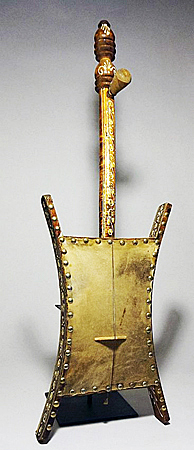
Owner: HWMC
Catalog#: 2ME-CHLT-03
Lutes
Yemen ‘Rebab’ (Lute A)
Yemen
Arabs -Bedouin Musicians
Wood, horsehair, metal tacks, paint
Mid 20th century
Height: 31 in; Width: 9.5 in
Chordophones – Lutes
The instrument name rebab is related to several bowed and plucked string instruments that were spread via the Islamic trading routes over North Africa, Southeast Asia, the Middle East, and parts of Europe. There were three main types: The long necked bowed variety often referred to as spike fiddles; the short-necked double-chested or boat-shaped variant that could be plucked; and the pear-shaped body that became the rebec in western Europe.
This bowed Yemen rebab is of the long necked, spike fiddle type that comes from the Bedouin people mainly located in the Arabian Peninsula region and Egypt. It has a wooden neck and tuning peg for the horsehair string. Animal hide is stretched across the frame on both sides and is attached with decorative metal tacks which continue down the length of the frame. The sides of the framed body, as well as the neck are decorated with white and gold paint and glitter paint in a swirling design. The finial is ornately carved and decorated in a similar fashion.
The Bedouin are known for playing complex musical performances all within the limited range of just over an octave on this instrument. The hand-crafted rebab comes in many shapes and sizes, with some areas using two or three strings.
